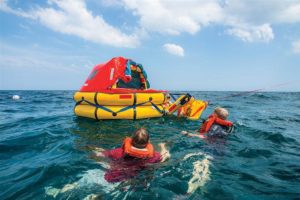 The Survival at Sea training is for any one working at sea, or dock workers exposed to sea.
The Survival at Sea training is for any one working at sea, or dock workers exposed to sea.
This is a value added course.
The purpose of this sea survival training is to provide the essential knowledge and experience of personal survival principles to maximise the chances of survival in the event of an emergency, including practical training in the use of life jackets and inflatable life rafts.
Trying to stay alive at sea during emergency situations requires a lot of hard work, perseverance and definitely a lot of patience. Before being rescued by the rescue party, one has to take-on the wrath and agony of the sea and improvise on every different situation that persists.
However, certain life threatening situations need a different approach and informed adaptation to the basic survival skills, and one of them is to – stay afloat at the sea!
Staying afloat at sea with no boat or life raft in sight is no different a survival basic. It depends upon the ability of the survivor to use the available survival techniques and in lieu with the improvised ones.
The greatest danger to a life floating in sea is its submission to cold water or if considered precisely, it is death due to something known as “Hypothermia” – a condition where a survivor, when immersed in cold water, experiences substantial loss of body heat to the surroundings, lowering the core body temperature to below the normal survival temperature.
PRE- COURSE REQUIREMENTS
Candidates must be over 16 and must have a basic level of fitness in order complete the practical pool drills.
COURSE CONTENT
Course covers following:
- Types of emergency situations such as collision, fire, sinking
- Types of life-saving appliances normally carried on ships
- Equipment in survival craft
- Location of personal life-saving appliances
- Principles concerning survival at sea.
Practical instruction / Swimming pool:
- Donning a life jacket
- Donning and use of an immersion suit
- Safely jumping from a height into the water
- Righting an inverted life raft while wearing a life jacket
- Swimming while wearing a life jacket and keeping afloat
- Boarding a liferaft from the ship or the water while wearing a life jacket
- Taking initial actions on boarding a liferaft to enhance chance of survival
- Streaming a drogue or sea anchor
- Bringing aboard an injured person
- A Group survival exercise.
COURSE DELIVERY
The course consists of lectures, films and demonstrations.
ASSESSMENT AND CERTIFICATION
On completion of the course you will receive the Survival at Sea certificate.
Course Fee INR Duration Course Timing Date Commence Remarks
Survival at Sea
8,000 1 Day
10:00-18:00 Wednesday
SaturdayPractical Exercises
